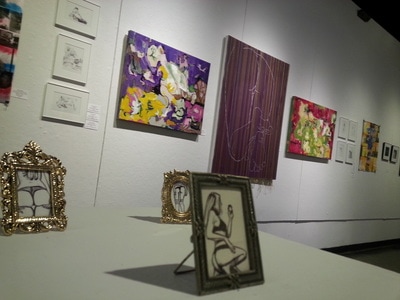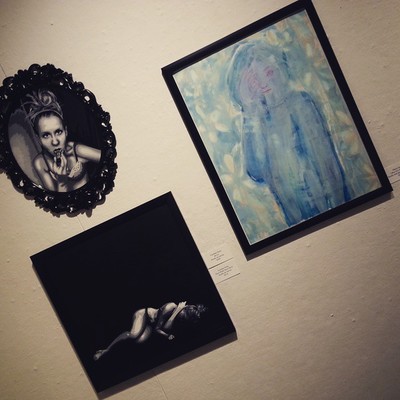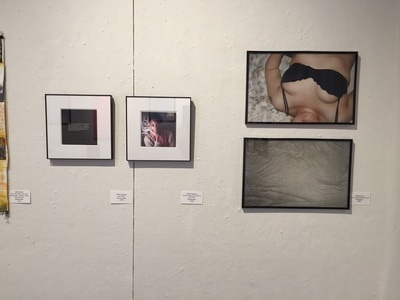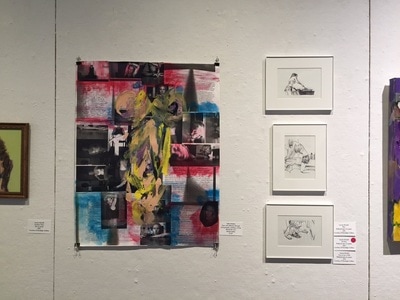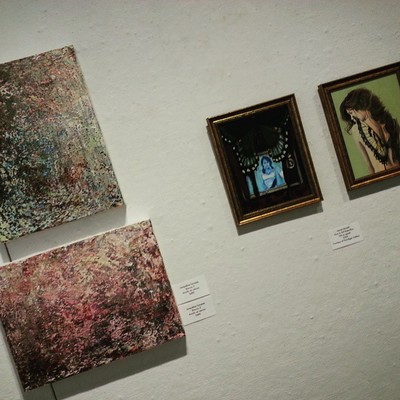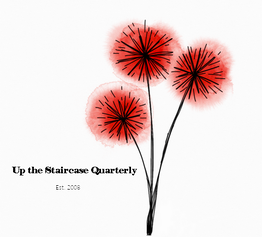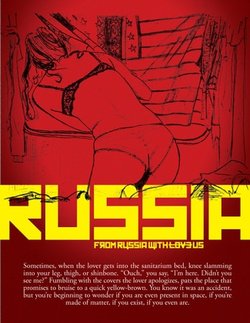
Les Femmes Folles: TALES, Featuring Lauren Rinaldi
Location: Monongalia Art Center in Morgantown, West Virginia
Dates: May 8 - 30, 2015
Review by Sally Deskins
Sometimes, when the lover gets into the sanitarium bed, knee slamming into your leg, thigh or shinbone. “Ouch,” you say, “I’m here. Didn’t you see me?” Fumbling with the covers the lover apologizes, pats the place that promises to bruise to a quick yellow-brown. You know it was an accident, but you’re beginning to wonder if you are even present in space, if you’re made of matter, if you exist, if you even are.
~ from “From Russia with Love,” The Hunger of the Cheeky Sisters: Ten Tales (Les Femmes Folles Books, 2015; fiction by Laura Madeline Wiseman; art by Lauren Rinaldi)
The written excerpt by Laura Madeline Wiseman graces a broadside with excerpted drawing by Lauren Rinaldi from The Hunger of the Cheeky Sisters: Ten Tales, the 2015 collaborative book by Les Femmes Folles Books. The second such collaborative book (the first:Intimates and Fools, 2014, with poetry by Wiseman and art by myself) for Les Femmes Folles Books, an offshoot from the organization Les Femmes Folles, which was founded in 2011 after an exhibition of work exploring the female body by five women, curated by artist Wanda Ewing. The above excerpt truly captures what it is we are exploring with Les Femmes Folles through our books, events and exhibitions: women in art and the experiences and perspectives thereof.
In fact, as it is, this broadside is part of an exhibition themed around this book, Tales, featuring the work of Rinaldi from the book, alongside artwork by fifteen other artists from around the nation, exploring girlhood, coming-of-age, beauty, and the female body. This is the seventh Les Femmes Folles exhibition. It comes full circle from the first exhibition with more adult themes, to this one, with more of a youthful exploration of the body.
In full disclosure, I am founder of Les Femmes Folles, and co-curator of the mentioned exhibition (as well as a participating artist) now on view at Monongalia Art Center through May 30, 2015. The work is of such esteem and poignancy that I find myself, a writer as well, compelled to write more about it, to reach as many people with the power that are these artists and their works.
Rinaldi co-curated the exhibition with me, as the artist of the book that inspired the exhibition. We had the pleasure of going through dozens of entries earlier this spring to select the artists that are shown today: Cheryl Angel, Launa Bacon, Tracy Brown, Chuka Susan Chesney, Kim Darling, myself, Jacqueline Ferrante, Michelle Furlong, Sheila Grabarsky, Marisa Lewon, Cathleen Parra, Christie Neptune, Courtney Kenny Porto, Rinaldi, and Marlana Adele Vassar.
Lauren Rinaldi’s work is juxtaposed throughout the gallery, including her notably “cheeky sketches,” as well as paintings and broadsides, providing a lush foundation and overt assimilation of the intimate figurative exploration (and book) that is Tales. Three mini-drawings (approximately 2”x 1” each) inside ornate gold frames welcome visitors, inviting a close look at the selfie-like playful drawings of feminine bums. Behind them lie the cover painting, Swallow Tales, and How To Kill Butterflies, a surreal image of a woman in a tank-top; upon closer inspection, she is an image on a television screen, framed by a butterfly and black bugs. This rich work, like her smaller drawings, reels viewers in with the raw imagery, and provokes with the layered context underneath. Drawings such as “Ribs,” “The Cutoff,” and “How to Be a Wife” of anonymous women (sometimes sans head) in domestic settings (grill, pregnant, kitchen floor) are reminiscent of Cindy Sherman’s early Film Stills. Like Sherman, Rinaldi’s images provide a mysterious woman and want for narrative, but without conclusion, giving comment on woman’s many deemed roles, challenging viewers to move beyond stereotypes and first impressions.
Location: Monongalia Art Center in Morgantown, West Virginia
Dates: May 8 - 30, 2015
Review by Sally Deskins
Sometimes, when the lover gets into the sanitarium bed, knee slamming into your leg, thigh or shinbone. “Ouch,” you say, “I’m here. Didn’t you see me?” Fumbling with the covers the lover apologizes, pats the place that promises to bruise to a quick yellow-brown. You know it was an accident, but you’re beginning to wonder if you are even present in space, if you’re made of matter, if you exist, if you even are.
~ from “From Russia with Love,” The Hunger of the Cheeky Sisters: Ten Tales (Les Femmes Folles Books, 2015; fiction by Laura Madeline Wiseman; art by Lauren Rinaldi)
The written excerpt by Laura Madeline Wiseman graces a broadside with excerpted drawing by Lauren Rinaldi from The Hunger of the Cheeky Sisters: Ten Tales, the 2015 collaborative book by Les Femmes Folles Books. The second such collaborative book (the first:Intimates and Fools, 2014, with poetry by Wiseman and art by myself) for Les Femmes Folles Books, an offshoot from the organization Les Femmes Folles, which was founded in 2011 after an exhibition of work exploring the female body by five women, curated by artist Wanda Ewing. The above excerpt truly captures what it is we are exploring with Les Femmes Folles through our books, events and exhibitions: women in art and the experiences and perspectives thereof.
In fact, as it is, this broadside is part of an exhibition themed around this book, Tales, featuring the work of Rinaldi from the book, alongside artwork by fifteen other artists from around the nation, exploring girlhood, coming-of-age, beauty, and the female body. This is the seventh Les Femmes Folles exhibition. It comes full circle from the first exhibition with more adult themes, to this one, with more of a youthful exploration of the body.
In full disclosure, I am founder of Les Femmes Folles, and co-curator of the mentioned exhibition (as well as a participating artist) now on view at Monongalia Art Center through May 30, 2015. The work is of such esteem and poignancy that I find myself, a writer as well, compelled to write more about it, to reach as many people with the power that are these artists and their works.
Rinaldi co-curated the exhibition with me, as the artist of the book that inspired the exhibition. We had the pleasure of going through dozens of entries earlier this spring to select the artists that are shown today: Cheryl Angel, Launa Bacon, Tracy Brown, Chuka Susan Chesney, Kim Darling, myself, Jacqueline Ferrante, Michelle Furlong, Sheila Grabarsky, Marisa Lewon, Cathleen Parra, Christie Neptune, Courtney Kenny Porto, Rinaldi, and Marlana Adele Vassar.
Lauren Rinaldi’s work is juxtaposed throughout the gallery, including her notably “cheeky sketches,” as well as paintings and broadsides, providing a lush foundation and overt assimilation of the intimate figurative exploration (and book) that is Tales. Three mini-drawings (approximately 2”x 1” each) inside ornate gold frames welcome visitors, inviting a close look at the selfie-like playful drawings of feminine bums. Behind them lie the cover painting, Swallow Tales, and How To Kill Butterflies, a surreal image of a woman in a tank-top; upon closer inspection, she is an image on a television screen, framed by a butterfly and black bugs. This rich work, like her smaller drawings, reels viewers in with the raw imagery, and provokes with the layered context underneath. Drawings such as “Ribs,” “The Cutoff,” and “How to Be a Wife” of anonymous women (sometimes sans head) in domestic settings (grill, pregnant, kitchen floor) are reminiscent of Cindy Sherman’s early Film Stills. Like Sherman, Rinaldi’s images provide a mysterious woman and want for narrative, but without conclusion, giving comment on woman’s many deemed roles, challenging viewers to move beyond stereotypes and first impressions.
Christie Neptune’s intense duo of works explores perspective and impression as well but with a textual component, providing a prolific and moving context for viewers. “Dark Fetish” explains with white ink on black paper, “a certain mystique about darker skin.” The coinciding photograph, “Tuesday February 3, 2015 at 10.21 PM,” shows a young woman, cheek in hand, with watery eyes, looking just to the side of the camera/viewer angle. These minimalist works cause great pause for viewers, inviting further introspection about the body and womanhood with an inter-sectional lens, but also with Neptune's own personal strength of narrative that is evidenced in her other work.
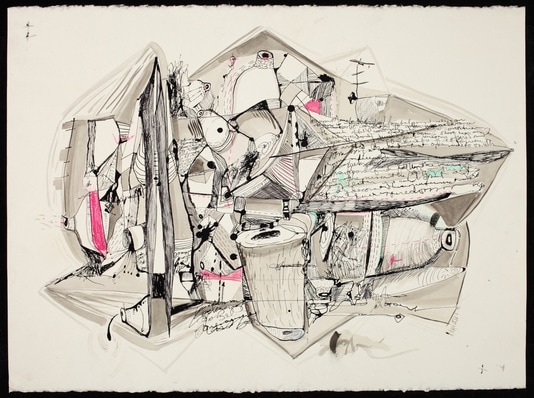 "Sustenance" by Kim Darling
"Sustenance" by Kim Darling
Next to Neptune’s are Cathleen Parra’s diptych photographs, “Bra of the Exquisite Truth Series.” The image displayed above shows a torso of a woman laying down on a flowered sheet clad in a simple black bra; the bottom image an empty sheet. As Neptune’s worked directly with minimalism to provoke viewers, Parra’s works as well, showing absence to ignite further thought on issues of the body, domesticity and inner realities.
My works for this exhibition utilize photography as well, but with a blast from the past. I went through my old journals from my teenage years, and found some self-portrait photographs I made (with film cameras), and my two favorite books as a teen: Go Ask Alice and The Bell Jar. I photocopied selections from all three, collaged them onto a board, and with my daughter, painted them to show a literal process of moving beyond the somewhat (albeit not without benefits as a teen expressing herself) egotistical and even silly teen dramas that, of course, still ring in my mind from time to time. Thereafter, I brought my recent method of body-printing onto all of it, to attempt to bring it full circle; my body prints abstract the body, no longer seeing it as I attempted to literally or culturally dictate, in my self-portraits, writing and reading.
Kim Darling tears apart the body as well in her mixed media work, but not with collage. Darling’s “Embodiments” and “Sustenance” exhibit her trademark: seemingly freewheeling gesture line drawing with torn-up body parts and animal limbs, as well as an almost-legible cursive handwriting. Reminiscent of graffiti artists and surrealistic line drawing, the works give heavy action-oriented, abstracted, and fractured perspectives of the body, relaying a similar feeling we might experience when dealing with the multi-modal world today.
Jacqueline Ferrante’s “Breccia IV” and “Breccia V” also provide abstract renditions, exploring decay as the title is a rock composed of broken fragments of minerals or rock cemented together by a fine-grained matrix that can be similar to or different from the composition of the fragments, in highly immaterial, yet glowing and beautiful format. The result gives pause in this exhibition of more direct, literal figurative work, into the thinking of the body beyond its matter, and relates back to the book excerpt above.
Sheila Grabarsky’s paintings are also abstracted, but in a manner perhaps more recognizable as feminine, with brushes of pinks and purples, resembling flowers and meadows. Still, in “Some Birds Don’t Fly,” and “Meadow Romp,” viewers can seek out figures and even narratives with her expressive brushstrokes, and the curious addition of a yarn in the form of a comic text box.
Michelle Furlong uses text in her image “Femme,” an abstracted view of one of her painted globes. The glass globe itself is a round form painted abstractly, but when photographed, becomes a womanly form in itself, in pink, with the title text in white, exuding a celebratory female presence.
Marlana Adele Vassar’s “The Visionary” is commemorative in title and in format. A young woman’s face and neck are painted in opulent brown hues in a swirling, abstracted environment. Rectangle and triangle shapes weave in and out, playing with perspective, as the young woman stares with her sparkling eyes straight at the viewer, a delicate and strong existence at once.
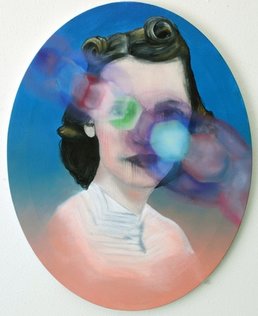 "Flare Element of Fraunhofer II" by Launa Bacon
"Flare Element of Fraunhofer II" by Launa Bacon
Launa Bacon’s “Flare Element of Fraunhofer II” is a haze of what could be an upright, neat portrait of a young woman in the 1950s with an up-do. An abstracted rainbow reflection is placed across her face, and her skin is smeared with a paintbrush, distorting this potentially jolly, yet perhaps masked image, questioning perceptions of what and how we see young women.
Marisa Lewon plays with perspective as well in “Touch” and “Feet” as viewers look at the enlarged torso and bum respectively, through colored embroidery that is lined across the paintings. The images themselves striking, the embroidery provides another layer of domesticity, or perhaps of space between the viewer and subject, or viewer and artist, that is silent when viewing art, and many times, the female body.
Courtney Kenny Porto puts the viewer-subject relationship on full view as well, in “Mirror” and “These Walls Were Black.” In “Mirror,” the black and white painting of a young woman putting on lipstick seemingly up close to a mirror, inside an oval ornate frame that might don a bathroom mirror, plays with intimacy and the process of beauty. Viewers feel like they are peeking into a private setting in “These Walls Were Black” showing a barely clothed woman lying, alseep or downtrodden, in a pitch black environment. Are we seeing her on stage, or at night through a window in her room? Porto utilizes the perspective of the viewer to make poignant comments on what it is to be a woman in this multi-mass-media world today.
Marisa Lewon plays with perspective as well in “Touch” and “Feet” as viewers look at the enlarged torso and bum respectively, through colored embroidery that is lined across the paintings. The images themselves striking, the embroidery provides another layer of domesticity, or perhaps of space between the viewer and subject, or viewer and artist, that is silent when viewing art, and many times, the female body.
Courtney Kenny Porto puts the viewer-subject relationship on full view as well, in “Mirror” and “These Walls Were Black.” In “Mirror,” the black and white painting of a young woman putting on lipstick seemingly up close to a mirror, inside an oval ornate frame that might don a bathroom mirror, plays with intimacy and the process of beauty. Viewers feel like they are peeking into a private setting in “These Walls Were Black” showing a barely clothed woman lying, alseep or downtrodden, in a pitch black environment. Are we seeing her on stage, or at night through a window in her room? Porto utilizes the perspective of the viewer to make poignant comments on what it is to be a woman in this multi-mass-media world today.
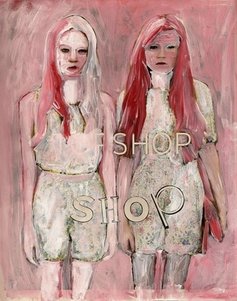 "Shop Shop, Buy and Comply" by Tracy Brown
"Shop Shop, Buy and Comply" by Tracy Brown
Tracy Brown and Cheryl Angel’s work give haunting outlooks on more youthful elements of femaleness. Angel’s “I Miss You This Much” and “Tears Are Diamonds I Can’t Cash In” are spooky yet vibrant abstracted portraits of young girls with long ghostly hair. The combination of blurry atmosphere with cheery colors gives a mysterious, naïve aura. Brown’s “Shop Shop, Buy and Comply” and “Beware” also seem to blur out the recognizable details of young women. “Shop Shop, Buy and Comply” is a pink digital and paint piece of two eerie girls staring at the viewers, akin to many-a horror flick at the end of a hallway, but the pink brings an ironic vibe. “Beware” is a woman, walking away and looking back, too abstracted with almost a scary clown face, amongst a surreal background of a beach or industrial scene; as details are unclear, we are left with our own imaginations amongst the seemingly bizarre happier yellow hues.
Chuka Susan Chesney’s are surreal narratives as well, a bit more light, perhaps. “Brooke, Michael and the Lady in the Mirror” is an expressive, detail-rich portrait of a trio of figures, smiling brightly, in fact more than brightly with enlarged teeth, a pleasing image yet also curious narrative. So too is “Where Have You Been” a line drawing with pastel on lined paper of a woman in a blue dress sitting on a chair, in a raw, abstracted environment. The woman sits, Alice Neel like, as if for the portrait, not beautified but with genuine tactile quality. Though the background is abstract, her presence is felt.
Chuka Susan Chesney’s are surreal narratives as well, a bit more light, perhaps. “Brooke, Michael and the Lady in the Mirror” is an expressive, detail-rich portrait of a trio of figures, smiling brightly, in fact more than brightly with enlarged teeth, a pleasing image yet also curious narrative. So too is “Where Have You Been” a line drawing with pastel on lined paper of a woman in a blue dress sitting on a chair, in a raw, abstracted environment. The woman sits, Alice Neel like, as if for the portrait, not beautified but with genuine tactile quality. Though the background is abstract, her presence is felt.
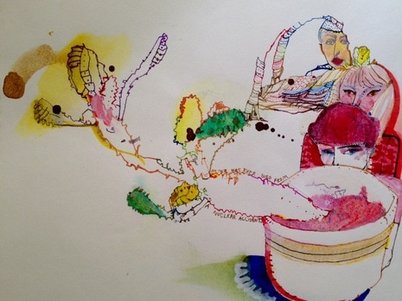 "Cactus women" by Chucka Susan Chesney
"Cactus women" by Chucka Susan Chesney
So too, with “Cactus People;” women’s eyes don the shape of a cactus along with the shape of a cactus line drawn with changing colored inks. The viewer’s eye follows around the plant, through the women’s eyes and back again, each line seeming to hold emotions themselves.
This is what I had hoped for with the exhibition; women exploring and exuding experience via their own (real or fictional) stories and perspective. Each is different and holds such strength on its own, whilst together, tells a rich story.
To hone the importance of such expressions, my own contribution invited the viewers with an open journal to share their own, serious or silly, teen ails. To maybe provide comfort or ideas, I put on view one of my teen journals for perusal, with a stack of free mini-journals to take if they felt inspired.
I hope you enjoyed this admittedly biased review; again, as usual, this exhibition and Les Femmes Folles does not attempt or aim to represent all women, but is a celebration of the women featured in this exhibition, a small address to the national and looming issue of under-(and mis)-representation of women in art institutions, sales, and texts which perpetuates the myth of the outlier woman artist.
The exhibitors as well as the MAC also invite viewers to donate in-kind donations to Morgantown’s Rape and Domestic Violence Information Center. There is also a special event May 19, 7:30pm, a free viewing of !Women Art Revolution (2011). Details can be found on the Les Femmes Folles website.
This is what I had hoped for with the exhibition; women exploring and exuding experience via their own (real or fictional) stories and perspective. Each is different and holds such strength on its own, whilst together, tells a rich story.
To hone the importance of such expressions, my own contribution invited the viewers with an open journal to share their own, serious or silly, teen ails. To maybe provide comfort or ideas, I put on view one of my teen journals for perusal, with a stack of free mini-journals to take if they felt inspired.
I hope you enjoyed this admittedly biased review; again, as usual, this exhibition and Les Femmes Folles does not attempt or aim to represent all women, but is a celebration of the women featured in this exhibition, a small address to the national and looming issue of under-(and mis)-representation of women in art institutions, sales, and texts which perpetuates the myth of the outlier woman artist.
The exhibitors as well as the MAC also invite viewers to donate in-kind donations to Morgantown’s Rape and Domestic Violence Information Center. There is also a special event May 19, 7:30pm, a free viewing of !Women Art Revolution (2011). Details can be found on the Les Femmes Folles website.

Sally Deskins is an artist and writer. Currently a Teaching Assistant in the Art History Graduate Program at West Virginia University, her work explores womanhood and motherhood in her life and others. Her work has been published and exhibited nationally. She illustrated Intimates and Fools (Les Femmes Folles Books, 2014, poetry by Laura Madeline Wiseman) and the forthcoming Leaves of Absence: An Illustrated Guide to Common Garden Affections (Red Dashboard, poetry by Laura Madeline Wiseman, Nov. 2015). She is founding editor and curator of Les Femmes Folles, an organization promoting women in art. sallydeskins.tumblr.com
